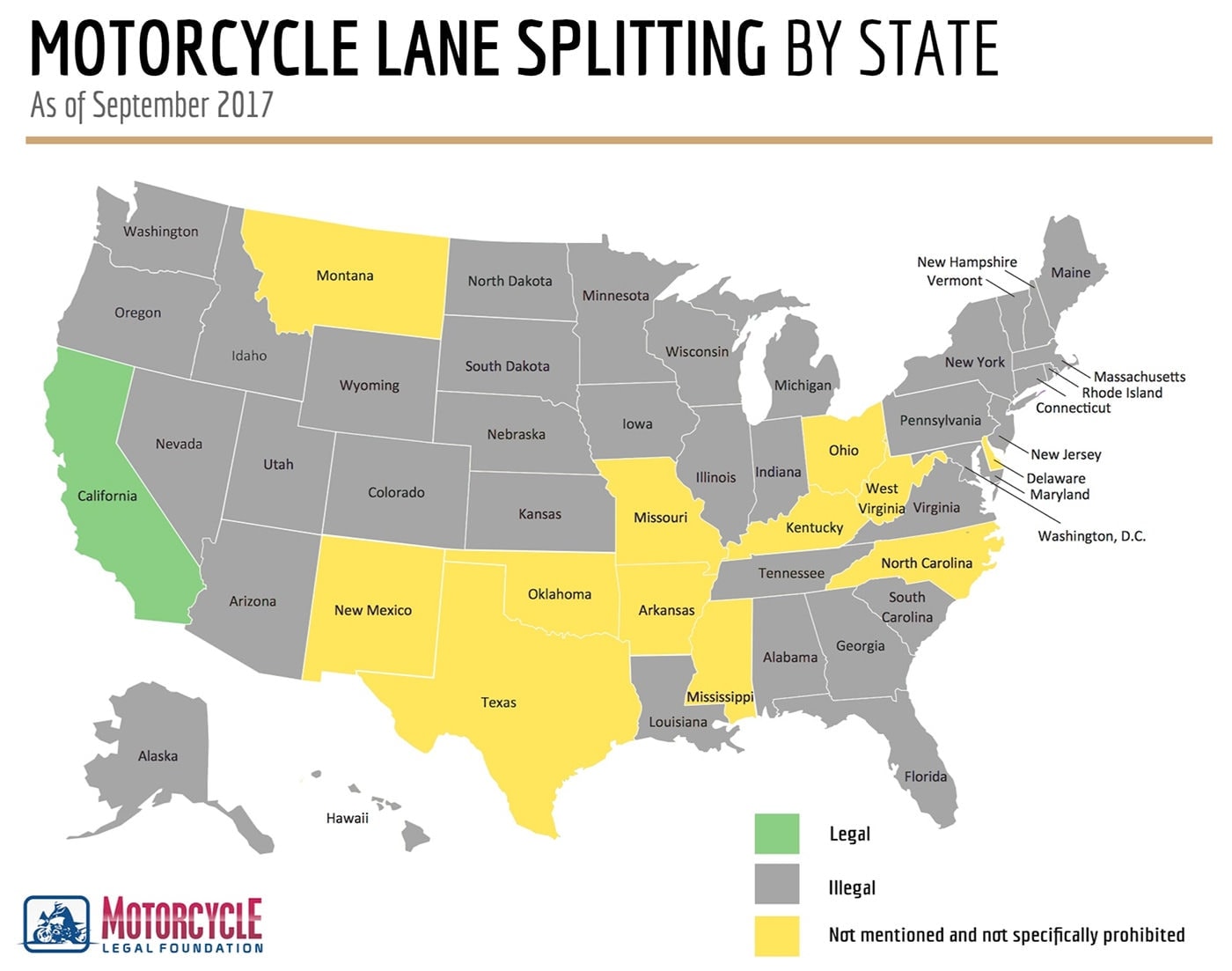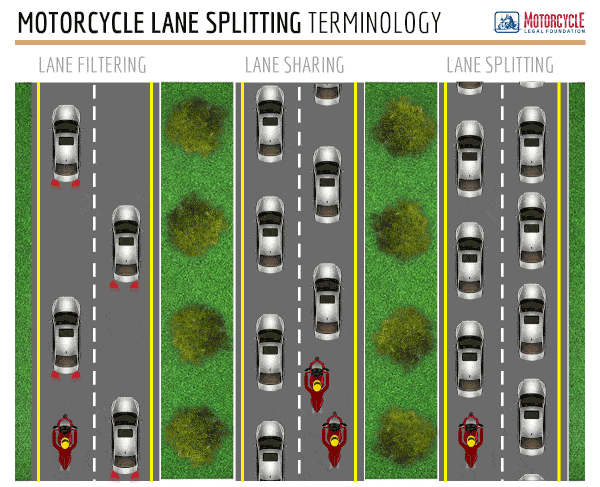Motorcycle Lane Splitting: Legality by State + Guidelines
The Legal Definition of Lane Splitting
Lane Filtering, Lane Sharing, and Lane Splitting
Safety Guidelines
Safety Precautions
The Four R’s
Do’s and Don’ts of Lane Splitting
You either love it or hate it, lane splitting is a controversial subject that doesn’t seem to promote any middle ground. However, you can no longer ignore it in California.
On January 1st, 2017, California’s pro-lane splitting Bill, AB-51 went live. Technically speaking, the subject of riding a motorcycle between two rows of traffic on Californian roads has always been a gray area.
Neither legal nor illegal, the California Highway Patrol (CHP) used their discretionary powers to determine whether it was being used or abused on a case-by-case basis. In 2015, the Department of Motor Vehicles (DMV) and the CHP published their safe strategy documents on the subject. At this point, the chain lube hit the proverbial fan.
One out of California’s 39 million residents wrote to the Office of Administrative Law complaining that the CHP had exceeded its authority by issuing such guidelines. Subsequently, both agencies withdrew the text and web versions.
The AB-51 Bill has now been joined by Section 21658.1 of the California Vehicle Code, which in effect, legalizes lane splitting. It also leaves it in the hands of the CHP to determine safety guidelines.
Is Lane Splitting Legal in my State?
As of September 2017, lane splitting is currently only legal in California, however there are some states where it isn’t explicitly declared as illegal. Many have been asking about the legality in their own states so we scoured the statutes for each and put together this chart below.

Note that it’s up to the Highway Patrol to determine if your act is unsafe, which means you can still get a ticket, even though your state may not have a law forbidding it.
Definition of Lane Splitting
According to the State of California’s Legislative Information portal , lane splitting is now legally defined as, a ‘motorcycle ridden between rows of stopped or moving vehicles in the same lane including on both divided and undivided streets, roads or highways.’
California is currently the only state to officially recognize lane splitting, so its other pseudonyms such as filtering, lane sharing, and white lining that have different definitions in the other 49 states.
Lane Filtering, Lane Sharing, and Lane Splitting

Filtering refers to a motorcycle picking its way through slow-moving or stationary traffic, such as at a stoplight.
Lane sharing covers two riders in the same lane, either side by side or a staggered formation.
Lane splitting aka White lining refers to a rider who stays predominantly on the lane dividing line. (This type of riding is considered bad practice and one that lane splitters would normally condone.)
As a general rule of thumb, lane splitting do’s and don’ts are best governed by a healthy survival instinct. More importantly, if you don’t feel confident enough to do it, then you don’t have to.
Safety Guidelines
Guidelines from the CHP’s Motorcycle Safety Program suggest that a motorcycle should travel no more than 10mph faster than the traffic it is passing. It is also not advisable to do this when traffic starts moving at 30mph or over. The faster you pass, the less time you have to react to an adverse situation.
The lanes that are safest to split are between lanes one and two, which are the furthest left. The lanes furthest to the right see the most movement regarding traffic adjusting for on-ramps and exits, making it a lot more dangerous to lane split. By using the far left lanes, you will be clear of trailers and semis, meaning that you will be able to see over the top of most vehicles, giving you a heads up of traffic flow ahead.
If you see a rider splitting a lane to your right, ease back. Don’t attempt to stay parallel as you could be pushing traffic into each other’s path, as drivers move over to avoid you.
Much like motorcycling in general, lane splitting can be a daunting prospect for the uninitiated. If it doesn’t look like you’ll fit through the gap, don’t attempt to do so. Similarly, if you find two long vehicles running parallel to each other, wait for them to re-position. If they close the gap when you are halfway through, you’re out of options.
Safety Precautions
On the subject of tight spaces, take a look at your bike from the front. Do you have wide bars, fairing, panniers, forwards, or engine bars? The object of this exercise is to give you a better appreciation of physical size.
Now add two feet either side. That’s the minimum that you will need if you take into account vehicle wing mirrors and the lateral movement of your bike from potential buffeting or raised line markings.
“Lane splitting keeps riders safer by eliminating their exposure to rear-end collisions, and it helps ease congestion by effectively removing motorcycles from the traffic lanes.”
The Four R’s
Whenever the subject of lane splitting is up for discussion, the four R’s will come into play. These refer to the following: Be Reasonable, Be Responsible, Be Respectful and Beware Roadways.
Be Reasonable with your speed, as going too fast turns you into a liability to yourself and others.
Be Responsible. You are solely responsible for your safety, so make sure your decisions and actions convey this, as it also affects the people that surrounds you.
Be Respectful to other road users. Safely acknowledge someone who gives you extra room prior to lane splitting. Remember, although you may be legally allowed to split, other road users aren’t legally obliged to make space for you.
Beware of Roadways, for when it is combined with traffic, it can equate to potential danger. You need to be super aware of poor and uneven surfaces, wide vehicles, inattentive drivers, and poor weather. It therefore stands to reason, that it’s important to stay focused at all times in order to respond to any potential dangers. Remember to stay alert, be sensible, and if it feels wrong, ease back.
Do’s and Don’ts of Lane Splitting
- DON’T make drivers over-react. If you ride too fast, all they’re going to see is something flash-by in their peripheral vision.
- DO stay in a gear that keeps the revs low. Both of these actions may cause a distracted driver to swerve.
- DON’T be physically prepared without being mentally prepared for riding between traffic. Yes, your survival instinct needs to be on full alert, but do ride with a positive, mental attitude.
- DO be aware of splitting in wet conditions. Riding on painted lines reduces grip when it rains.
- DO watch out for lumps, bumps, and uneven surfaces as they can upset the handling of your bike.
- DON’T think that the law protects you from riding badly. Bill AB-51/21658.1 makes the physical act of lane splitting legal under set circumstances and CVC 22400 makes it illegal for drivers to block or impede a motorcyclist. These facts however, doesn’t preclude anyone from extending common courtesy to other road users when executing the maneuver, so do be courteous!
From a motorcyclist’s point of view, lane splitting saves time, eases congestion, and keeps them out of harm’s way. According to Rob Dingman, President and CEO of the American Motorcyclist Association, ‘Lane splitting keeps riders safer by eliminating their exposure to rear-end collisions, and it helps ease congestion by effectively removing motorcycles from the traffic lanes.
The next time that you decide to lane-split, remember to stay alert, don’t take rash chances, stay within the safe speed limit, and treat other road users with courtesy. Ride safely!


